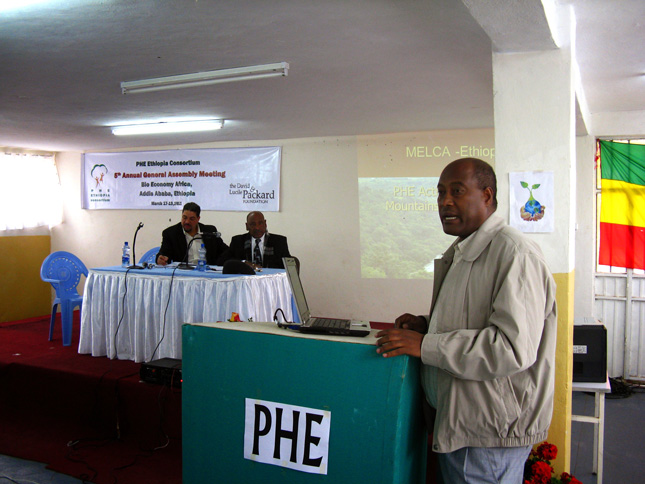-
The Continuing Challenges of Integrated Development
March 20, 2011 By Schuyler Null
“How are we going to feed all these mouths?” asked Bekele Hambissa, director of the Environmental Protection and Development Organization in Addis, on day two of the PHE Ethiopia Consortium general assembly (read about day one here). Environmental resources are directly tied to Ethiopia’s population growth, said Hambissa, during a discussion of balancing efforts to address population growth, environment, and livelihoods. While poverty alleviation is an important goal of population, health, and environment integration (PHE), it must be environmentally sustainable, he said.
The diversity and scope of the activities presented by eight of the consortium’s most active members was striking.. Each operates in a different part of the country, from the highlands of Tigray region in the north and Oromia in the south and central part of the country, to the coffee-producing Southern Nations and Peoples in the southwest. Though all the programs integrate some aspect of population, health, and environment in their development efforts, each emphasizes different aspects more than others and have differing implementation methods.
Farms, Forests, and Family Planning
LEM Ethiopia, headed by Mogues Worku, works in parallel with existing government infrastructure to provide sustainable income-generating opportunities and reproductive health services to women in three woredas (districts) across the country. The southern woreda of Wonago is very densely populated and severely eroded, he said, with up to 3,000 people per square kilometer. Along with agricultural training to produce “model farmers” in each community, LEM also suppers poor women by providing chickens and beehives, with one beehive capable of producing of to 45 kilograms of honey each year. These environmentally friendly alternative income sources help local families who often run short of money after the annual coffee harvest or have seen decreasing crop yields due to changing weather patterns, he said.
 LEM also provides reproductive health and family planning services (RH/FP) through government clinics. Since they first started working in their target woredas two years ago, access to RH/FP services has dramatically increased from 14, 18, and 25 percent to 65, 65, and 80 percent, respectively.
LEM also provides reproductive health and family planning services (RH/FP) through government clinics. Since they first started working in their target woredas two years ago, access to RH/FP services has dramatically increased from 14, 18, and 25 percent to 65, 65, and 80 percent, respectively.The Relief Society of Tigray (REST), by contrast, integrates PHE via watershed protection plans across several woredas in the north. REST focuses their health efforts on school programs, hoping to increase students’ awareness of RH/FP, HIV/AIDS, and basic sanitation.
The Movement for Ecological and Community Action (MELCA), working in the Bale Mountains in the south, also heavily engages with youth through schools, but focuses mainly on reforestation around the Bale Mountains National Park. Befekadu Refera, program head of MELCA, said they have planted more than 60,000 indigenous trees so far, and, thanks to active youth groups, they have increased the prevalence of all forms of contraceptives.
Data for Donors
As impressive as these numbers are, said Linda Bruce of the BALANCED Project, “it’s extremely important to continue to collect data.” Without statistics, integration is a tough sell to donors who’ve never seen PHE programs in action, she said.
Anecdotes are not enough, especially to prove the cost-effectiveness of the PHE approach, said Roger-Mark De Souza of Population Action International. He advised the consortium members to demonstrate it with data. “We have to be very rigorous and critical in our approach, to hold each other accountable,” he said.
Some members saw a lack of interest and understanding by donors, who often want projects to meet specific objectives that often don’t match up well with the broad results of PHE. Bruce and De Souza said that better communication of existing programs’ results might help alleviate this reluctance.
More and more donors are becoming interested in integrated development, said Jason Bremner, but “we need to know about your projects” to increase that interest. To that end, the members agreed they need more detailed surveying and better coordination between organizations around the country.
Strong Local Support
Despite the challenges, all members reported immediate impact and strong local support for their programs. Shewaye Deribe, program officer for the Ethio Wetlands and Natural Resources Association – which has helped rehabilitate more than 22,000 hectares and provide improved FP/RH services to more than 30,000 people – told the audience about an impoverished farmer with a very small plot of land and eight children, none of whom were able to complete high school because he could not feed them. “Learn from my example,” the man told Deribe.
Integration is naturally present in every community, said Worku. Farmers do not consider their land, family, or income in isolation; the only way to meet their basic needs is through a multi-disciplinary approach.
Photo Credit: From right to left, Befekadu Refera of MELCA, Haddis Mulugeta, and Roger-Mark De Souza; and below, a stack of logs in the village of Gele Gaber. Schuyler Null/Wilson Center.
Topics: Africa, agriculture, community-based, cooperation, development, Ethiopia, From Ethiopia, PHE, population, poverty, water
 A Publication of the Stimson Center.
A Publication of the Stimson Center.




